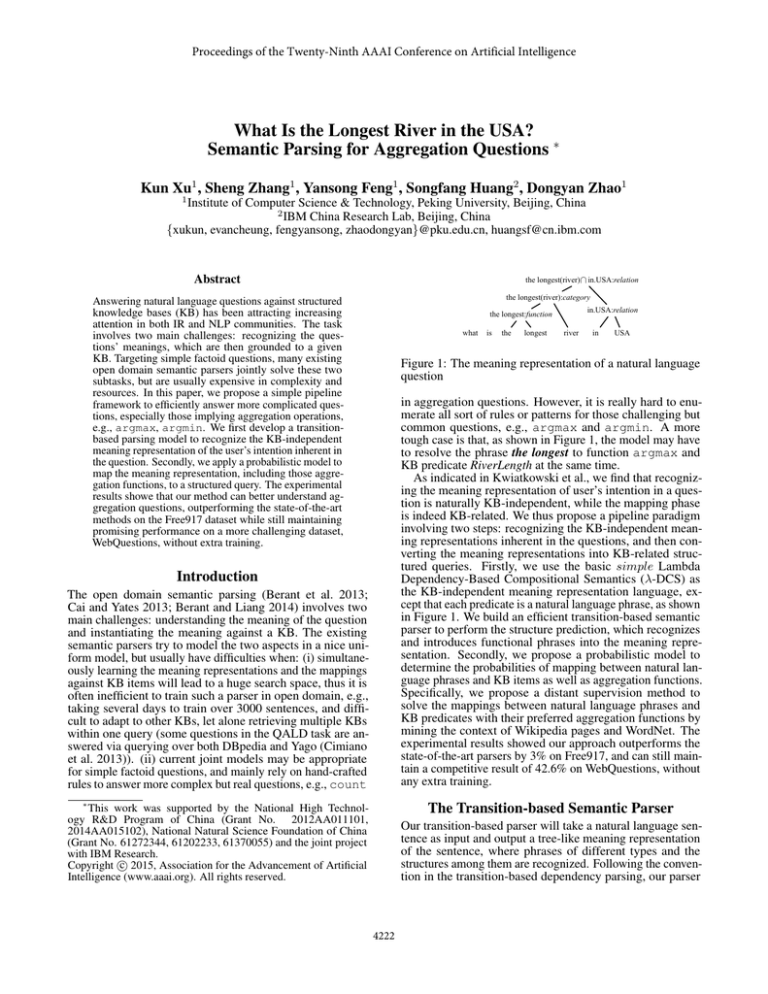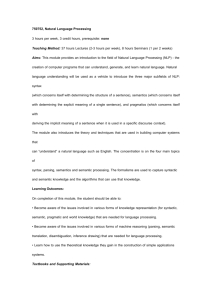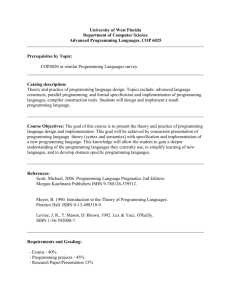
Proceedings of the Twenty-Ninth AAAI Conference on Artificial Intelligence
What Is the Longest River in the USA?
Semantic Parsing for Aggregation Questions ∗
Kun Xu1 , Sheng Zhang1 , Yansong Feng1 , Songfang Huang2 , Dongyan Zhao1
1
Institute of Computer Science & Technology, Peking University, Beijing, China
2
IBM China Research Lab, Beijing, China
{xukun, evancheung, fengyansong, zhaodongyan}@pku.edu.cn, huangsf@cn.ibm.com
Abstract
the longest(river) \ in.USA:relation
the longest(river):category
Answering natural language questions against structured
knowledge bases (KB) has been attracting increasing
attention in both IR and NLP communities. The task
involves two main challenges: recognizing the questions’ meanings, which are then grounded to a given
KB. Targeting simple factoid questions, many existing
open domain semantic parsers jointly solve these two
subtasks, but are usually expensive in complexity and
resources. In this paper, we propose a simple pipeline
framework to efficiently answer more complicated questions, especially those implying aggregation operations,
e.g., argmax, argmin. We first develop a transitionbased parsing model to recognize the KB-independent
meaning representation of the user’s intention inherent in
the question. Secondly, we apply a probabilistic model to
map the meaning representation, including those aggregation functions, to a structured query. The experimental
results showe that our method can better understand aggregation questions, outperforming the state-of-the-art
methods on the Free917 dataset while still maintaining
promising performance on a more challenging dataset,
WebQuestions, without extra training.
in.USA:relation
the longest:function
what
is
the
longest
river
in
USA
Figure 1: The meaning representation of a natural language
question
in aggregation questions. However, it is really hard to enumerate all sort of rules or patterns for those challenging but
common questions, e.g., argmax and argmin. A more
tough case is that, as shown in Figure 1, the model may have
to resolve the phrase the longest to function argmax and
KB predicate RiverLength at the same time.
As indicated in Kwiatkowski et al., we find that recognizing the meaning representation of user’s intention in a question is naturally KB-independent, while the mapping phase
is indeed KB-related. We thus propose a pipeline paradigm
involving two steps: recognizing the KB-independent meaning representations inherent in the questions, and then converting the meaning representations into KB-related structured queries. Firstly, we use the basic simple Lambda
Dependency-Based Compositional Semantics (λ-DCS) as
the KB-independent meaning representation language, except that each predicate is a natural language phrase, as shown
in Figure 1. We build an efficient transition-based semantic
parser to perform the structure prediction, which recognizes
and introduces functional phrases into the meaning representation. Secondly, we propose a probabilistic model to
determine the probabilities of mapping between natural language phrases and KB items as well as aggregation functions.
Specifically, we propose a distant supervision method to
solve the mappings between natural language phrases and
KB predicates with their preferred aggregation functions by
mining the context of Wikipedia pages and WordNet. The
experimental results showed our approach outperforms the
state-of-the-art parsers by 3% on Free917, and can still maintain a competitive result of 42.6% on WebQuestions, without
any extra training.
Introduction
The open domain semantic parsing (Berant et al. 2013;
Cai and Yates 2013; Berant and Liang 2014) involves two
main challenges: understanding the meaning of the question
and instantiating the meaning against a KB. The existing
semantic parsers try to model the two aspects in a nice uniform model, but usually have difficulties when: (i) simultaneously learning the meaning representations and the mappings
against KB items will lead to a huge search space, thus it is
often inefficient to train such a parser in open domain, e.g.,
taking several days to train over 3000 sentences, and difficult to adapt to other KBs, let alone retrieving multiple KBs
within one query (some questions in the QALD task are answered via querying over both DBpedia and Yago (Cimiano
et al. 2013)). (ii) current joint models may be appropriate
for simple factoid questions, and mainly rely on hand-crafted
rules to answer more complex but real questions, e.g., count
∗
The Transition-based Semantic Parser
This work was supported by the National High Technology R&D Program of China (Grant No. 2012AA011101,
2014AA015102), National Natural Science Foundation of China
(Grant No. 61272344, 61202233, 61370055) and the joint project
with IBM Research.
c 2015, Association for the Advancement of Artificial
Copyright Intelligence (www.aaai.org). All rights reserved.
Our transition-based parser will take a natural language sentence as input and output a tree-like meaning representation
of the sentence, where phrases of different types and the
structures among them are recognized. Following the convention in the transition-based dependency parsing, our parser
4222
includes a stack of partial derivations, a queue of incoming
words, and five types of actions: Shift-X (X∈ T = {entity,
relation, category, function, NIL}, where entity and category nodes potentially correspond to the unary predicates
of KB, relation nodes potentially correspond to the binary
predicates of the KB, function nodes correspond to aggregation functions in simple λ-DCS, e.g., count, argmax,
and argmin, and NIL are those that have no corresponding items in the KB) , Left-Reduce, Right-Reduce,
Combine-X, Combine-Y. (1)The Shift-X action removes the incoming word in the queue Q, pushes it on top of
the stack S as a new node, and assigns it with a semantic type
X ∈ T . (2)The Combine-X action pops the top two NIL
nodes from the stack, combines them into a new node assigning a semantic type X from the set T , and then pushes the new
node onto the stack. (3) The Combine-Y action pops the
top two non NIL nodes from the stack S, combines them by
operation Y ∈ {Join, Intersection, Aggregation} and pushes
the new node onto the stack. These operations correspond to
the operators in the λ-DCS. (4) The Left-Reduce action
pops the top two nodes from the stack and pushes the top
node back onto the stack. (5) The Right-Reduce action
pops the top node from the stack.
Free917
WebQuestions
n
Y
i=1
m
Y
Our+A
71.7%
42.6%
References
Auer, S.; Bizer, C.; Kobilarov, G.; Lehmann, J.; Cyganiak, R.; and
Ives, Z. G. 2007. Dbpedia: A nucleus for a web of open data. In
ISWC/ASWC, 722–735.
Bao, J.; Duan, N.; Zhou, M.; and Zhao, T. 2014. Knowledge-based
question answering as machine translation. In Proceedings of the
52nd Annual Meeting of the Association for Computational Linguistics (Volume 1: Long Papers), 967–976. Baltimore, Maryland: Association for Computational Linguistics.
Berant, J., and Liang, P. 2014. Semantic parsing via paraphrasing. In
Association for Computational Linguistics (ACL).
Berant, J.; Chou, A.; Frostig, R.; and Liang, P. 2013. Semantic
parsing on freebase from question-answer pairs. In EMNLP, 1533–
1544.
Bollacker, K. D.; Evans, C.; Paritosh, P.; Sturge, T.; and Taylor, J.
2008. Freebase: a collaboratively created graph database for structuring human knowledge. In SIGMOD Conference, 1247–1250.
Cai, Q., and Yates, A. 2013. Semantic Parsing Freebase: Towards
Open-domain Semantic Parsing. In Proceedings of the Second Joint
Conference on Lexical and Computational Semantics (*SEM).
Cimiano, P.; Lopez, V.; Unger, C.; Cabrio, E.; Ngomo, A.-C. N.; and
Walter, S. 2013. Multilingual question answering over linked data
(qald-3): Lab overview. In CLEF, 321–332.
Collins, M., and Roark, B. 2004. Incremental parsing with the perceptron algorithm. In ACL, 111–118.
Kwiatkowski, T.; Zettlemoyer, L. S.; Goldwater, S.; and Steedman,
M. 2010. Inducing probabilistic ccg grammars from logical form
with higher-order unification. In EMNLP, 1223–1233.
Kwiatkowski, T.; Choi, E.; Artzi, Y.; and Zettlemoyer, L. S. 2013.
Scaling semantic parsers with on-the-fly ontology matching. In
EMNLP, 1545–1556.
Suchanek, F. M.; Kasneci, G.; and Weikum, G. 2007. Yago: a core
of semantic knowledge. In WWW, 697–706.
Unger, C., and Cimiano, P. 2011. Pythia: Compositional meaning
construction for ontology-based question answering on the semantic
web. In Proceedings of the 16th International Conference on Natural
Language Processing and Information Systems, NLDB’11, 153–160.
Berlin, Heidelberg: Springer-Verlag.
Unger, C.; Bühmann, L.; Lehmann, J.; Ngomo, A.-C. N.; Gerber, D.;
and Cimiano, P. 2012. Template-based question answering over rdf
data. In WWW, 639–648.
Yahya, M.; Berberich, K.; Elbassuoni, S.; Ramanath, M.; Tresp, V.;
and Weikum, G. 2012. Natural language questions for the web of
data. In EMNLP-CoNLL, 379–390.
Yao, X., and Van Durme, B. 2014. Information extraction over
structured data: Question answering with freebase. In Proceedings
of ACL.
P (sdi |sindi )P (odi |oindi )P (pdi |pindi )
P (adj , fdj |aindj , findj )
j=1
where the (s, p, o) corresponds to the three parts of a query
triple: the subject s, predicate p and object o, and the (f, a)
corresponds to the two parts of the aggregation function: the
operation f and the argument a. In practice, we use the Freebase search API1 to compute the probabilities of mapping the
subject and object phrase. We apply the Naive Bayes model
to compute the probability of mapping the relation phrase.
To compute P (adj , fdj |aindj , findj ), We propose a distant
supervision method to collect co-occurrences of natural language phrases and KB predicates as well as their preferred
aggregation functions.
Experiment
Experimental Setup
We evaluate our system on two datasets, the Free917(Cai and
Yates 2013) and WebQuestions(Berant et al. 2013). Specifically, the Free917 dataset contains 917 questions annotated
with logical forms grounded to Freebase. The WebQuestions
dataset contains 5,810 question-answer pairs, with the same
training/testing split with previous work.
Main Results
We compare our system with the current state-of-the-art open
domain systems, (Berant and Liang 2014) and (Yao and
1
Our-A
71.3%
41.1%
Van Durme 2014). We also include a variant of our model
(Our-A), where we do not consider aggregation operations
during the second phase. In terms of step performances, our
model archives 81.2% for parsing accuracy in the first step,
and 86.7% of instantiation accuracy in the second step, on
Free917. And for overall performances, as shown in table 1,
our system obtains a system accuracy of 71.7% on Free917,
outperforming the state-of-the-art systems. On the WebQuestions dataset with much more predicates than Free917, our
system is still able to maintain a competitive performance,
achieving a F-measure of 42.6% without extra training on
WebQuestions. This result shows the novelty of our semantic
parser particularly on the meaning recognizing.
We apply a probability model to map the meaning representation Qind , which consists of n triples and m aggregation
phrases, to a structured query Qd , and we made necessary
independent assumptions, approximating P (Qd |Qind ) as:
≈
Yao14
42.0%
Table 1: Results on test sets of Free917 and WebQuestions
Instantiating Meaning Representation
P (Qd |Qind )
BCFL14
68.5%
39.9%
https://developers.google.com/freebase/
4223








